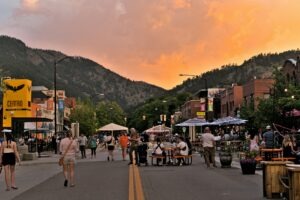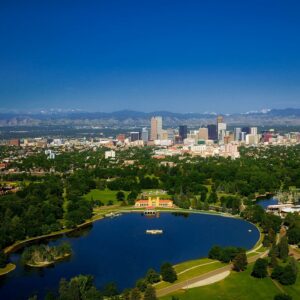Why is Colorado so Expensive? Top 4 Reasons in 2024 [Explained]
Colorado ain’t cheap anymore. So, why is Colorado so expensive in 2024?

When people think of Colorado, they often picture beautiful mountains, world-class skiing, and outdoor adventures. However, the state’s growing popularity has come with a downside: a sharp increase in the cost of living. One question on many people’s minds is, “Why is Colorado so expensive?” In recent years, Colorado has become one of the priciest places to live in the U.S., raising concerns for both current residents and potential newcomers.
This article will explore four top reasons why Colorado has become so expensive. These reasons include the high demand for housing, the state’s popularity as a tourist destination, the booming job market, and the impact of climate change. Let’s dive into each reason, backed by data and statistics.
Table of Contents
Methodology
To understand why Colorado has become so expensive, especially in recent years, we conducted thorough research using a combination of government reports, housing market data, and economic studies. Our research involved analyzing population growth trends, housing price data, and tourism statistics from reliable sources such as the U.S. Census Bureau, Zillow, the Colorado Tourism Office, and the Colorado Department of Labor and Employment.
Additionally, we reviewed environmental data from the Colorado State Forest Service to examine the impact of climate change on the state’s cost of living. We also considered reports from real estate organizations like the National Association of Realtors to provide insights into housing market trends.
By relying on these credible sources, we aimed to present an accurate and well-rounded view of why Colorado has become so expensive.
Why is Colorado so Expensive? Here are the Top 4 Reasons
1. High Demand for Housing
One of the most significant factors behind Colorado’s rising costs is the overwhelming demand for housing. Over the past decade, Colorado has experienced rapid population growth, leading to a surge in demand for homes. According to the U.S. Census Bureau, Colorado’s population grew by over 14% between 2010 and 2020, adding nearly 750,000 new residents.
This population boom has put immense pressure on the housing market, especially in urban areas like Denver, Boulder, and Colorado Springs. As more people move to Colorado, the competition for available homes intensifies, driving up prices. Zillow reported that the median home value in Colorado reached approximately $577,000 in early 2024, a massive increase from just over $250,000 in 2010.
Similarly, the National Association of Realtors ranked Denver among the top 10 most expensive metro areas in the U.S. in 2023. Renters aren’t immune to this trend either, with rents in Colorado climbing by more than 30% over the past five years. Despite ongoing construction, new homes are not being built quickly enough to keep up with demand.
Additionally, much of the new housing caters to higher-income buyers, leaving many middle- and lower-income families struggling to afford a place to live. As long as the demand for housing outpaces supply, prices are likely to continue rising, making Colorado an increasingly expensive place to call home.
So, why is Colorado so expensive? Mainly due to pure supply and demand. But what is driving the demand? Let’s keep diving deeper into the issue.
2. Popularity of Outdoor Recreation and Tourism
Another reason why Colorado is so expensive is its immense popularity as a destination for outdoor recreation and tourism. Colorado’s stunning natural landscapes, world-class ski resorts, and national parks attract millions of tourists each year, making tourism a major driver of the state’s economy. However, this popularity also contributes to higher living costs for residents.
According to the Colorado Tourism Office, the state welcomed over 93 million visitors in 2023, generating over $28 billion in revenue. Ski towns like Aspen, Vail, and Breckenridge are particularly expensive, driven by the influx of tourists and seasonal residents. For example, the average home price in Aspen was over $4 million in 2023, making it one of the priciest places to live in the country.
The short-term rental market, fueled by platforms like Airbnb, has also driven up costs. In many popular tourist areas, property owners are choosing to rent their homes to tourists rather than long-term residents, further reducing the supply of available housing for locals. While tourism brings significant economic benefits to Colorado, it also places pressure on housing markets and raises the cost of living in many areas.
3. Job Market Growth and Tech Industry Expansion
Colorado’s thriving job market, particularly in industries like technology, aerospace, and healthcare, is another key factor behind the rising cost of living. Over the past decade, Colorado has become a hub for tech companies and startups, drawing professionals from across the country. Cities like Denver, Boulder, and Fort Collins have seen rapid job growth, particularly in high-paying industries.
According to the Colorado Department of Labor and Employment, the state’s unemployment rate remained low at around 3% in 2023, which reflects a strong and growing economy. Major tech companies like Google, Amazon, and Oracle have opened offices in Colorado, bringing in thousands of new jobs and boosting the local economy.
However, this economic success has also driven up the cost of living. As more high-income workers move to Colorado for job opportunities, housing prices have soared, and competition for homes has intensified. This influx of wealthier residents has also led to rising prices for goods and services, making it more expensive for everyone to live in Colorado.
While the strong job market is a positive sign for the state’s economy, it is also a significant reason why Colorado has become so expensive in recent years.
4. Impact of Climate Change and Environmental Concerns
The effects of climate change are another factor contributing to the rising costs in Colorado.The state has been experiencing more frequent and severe wildfires, droughts, and other climate-related events, which have had a significant impact on the cost of living.
In recent years, Colorado has seen an increase in the number and intensity of wildfires, which have destroyed homes and infrastructure, leading to higher insurance costs and reconstruction expenses. According to the Colorado State Forest Service, the state experienced over 1,000 wildfires in 2023 alone, burning thousands of acres and causing millions of dollars in damage.
The rising threat of wildfires has made it more expensive to insure homes, particularly in high-risk areas near forests and wilderness. In addition to wildfires, Colorado has also been affected by prolonged drought conditions, which have strained water resources and increased utility costs. As water becomes scarcer, the cost of water for households and businesses has risen, contributing to higher living expenses. The impact of climate change on Colorado’s environment is likely to continue driving up costs in the coming years, making it a more expensive place to live.
Summary
In conclusion, Colorado has become an expensive place to live for several reasons. The high demand for housing, driven by rapid population growth, has significantly increased home prices and rents. The state’s popularity as a tourist destination, along with its booming job market and the expansion of industries like technology, has also contributed to rising living costs.
Additionally, the impact of climate change, including wildfires and droughts, has further driven up expenses for residents. While Colorado remains a beautiful and attractive place to live, these factors have made it increasingly difficult for many people to afford the cost of living. By understanding these reasons, current residents and potential newcomers can better navigate the challenges of living in this rapidly changing state.





